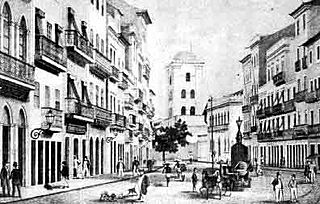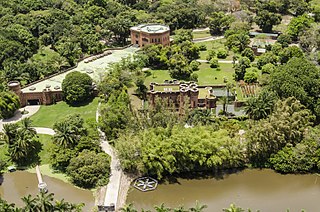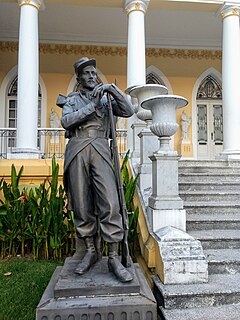
Below is a list of museums in Pernambuco, Brazil.

Below is a list of museums in Pernambuco, Brazil.
The Museum of Pernambuco State (Museu do Estado de Pernambuco or MEPE) Historical and anthropological museum housed in a 19th-century mansion (Lord Beberibe) in Recife, Capital of Pernambuco state, the "Museu do Estado de Pernambuco (MEPE)" dates back to 1929. From Masters who portrayed the Colonial period, as well as the Dutch invasion (1630) to 20th and 21st century, the museum comprises over 12 thousand art pieces and include panels about the battles of Monte Guararapes and Tabocas. Periodically the museum hosts the "Salão de Arte Contemporânea de Pernambuco" (Contemporary Art Exhibition) when emerging artists are selected to represent the new run of local professionals who will help to maintain and shape the new profile of the local art scenery.
Tuesday through Friday 9 am – 5 pm; Saturday and Sunday 2–5 pm
Kahal Zur Israel Synagogue Kahal Zur Israel The historic Recife synagogue in the Recife Antigo, --Old Recife—is the oldest one in the Americas, dating back to the 17th century. Reopened recently, Kahal is part of the Pernambuco historic patrimony. It was founded by Jews who were once expelled from Portugal and settled in the Netherlands. Some of those Jews immigrated to "New Holland" when the Dutch invaded the Northeastern portion of Brazilian lands occupied by the Portuguese. When the Portuguese, helped by Portuguese-Brazilians, reconquered the land, Recife Portuguese-Brazilian Jews moved further north with the Dutch, whose trips Jews patronized, where "New Amsterdam" was founded on Manhattan island. Thus, the first New York City synagogue was created by the founders of the first synagogue in the New World, in lower Manhattan. It later moved to the Upper West Side, where it is still called "The Portuguese and Spanish Synagogue."

Francisco Brennand Ceramic Workshop (Atêlier de Cerâmica)
Francisco Brennand, one of the most important names in contemporary sculptures in Brazil, displays around 2000 pieces of his ceramic works in enormous open sheds, between monuments, gardens and in the midst of an Atlantic forest reserve in Varzea neighborhood in Recife. Many of his works elaborate on abstract beings, that are sensuality symbols. Several anatomic parts are in his studies, mainly from the female body. He also uses ceramic to create floor and wall tiles as well as bricks for construction. His studio is set in an old brick factory that belonged to the sculptor's English family. Some of his work is an original and creative miscellaneous between the European-Amerindian-African-Egyptian cultures.
Monday through Friday - 8 am – 5 pm
Museum of the Man of the Northeastern (Museu do Homem do Nordeste) The broad collection describes Pernambuco's culture starting from three main themes: the sugar-cane production cycle, the northeastern man's life style and the folkloric and religious manifestations. Explore the culture heritage of Indian, Portuguese and African in the formation of the Northeast people. Examples since Mocambos, (poor clay houses) until the big Lord house (casa grande) and the Senzala (large slaves dormitory) are illustrated in this museum. Also, objects of worship, popular cloth dolls and ceramic from regional artists such as Vitalino, Zé Caboclo, Zé Rodrigues and anonymous people as well. All this makes up the body of the richest museum of cultural anthropology in Brazil.
Tuesday through Friday 8:30 am – 5 pm; Saturday and Sunday 1–5 pm
Gilberto Freyre Foundation This space keeps alive the memory of the Master of Apipucos, the writer and sociologist Gilberto Freyre(1900/87), immortalized between other major works in Casa Grande e Senzala. In the house museum, a 19th-century mansion, visitors can check the ecological site (living museum with pitangueiras trails and pau-Brazil trails). In addition to a rich library, with books collections, pictures, paintings, sculptures, crafts and personal objects that belonged to the sociologist.
Monday through Friday 9 am – 5 pm
Recife City Museum Set up in a room in Cinco Pontas Fort, it houses pictures, reproductions of old paintings (painted by Franz Post) and objects that describe Recife since the period of Dutch rule, such as over than one thousand antique photos, tableware, Portuguese and French tiles, among other pieces.
Tuesday through Friday 8 am – 6 pm; Saturday and Sunday 1–5 pm
Abolition Museum (Museu da Abolição) Is installed in a typical construction designated Engenho (Large owner of slaves house) called Great Magdalene House. It was inaugurated in 1983 and has on display in his memorial hall, several objects relating to the slavature in the 18th and 19th centuries. It has mini-auditorium and amphitheater where are developed educational and cultural programs. It's an African-Brazilian cultural reference.
Monday through Friday 8 am – 12 noon and 1–5 pm
Museum of Modern Art Aloisio Magalhães (Portuguese : Museu de Arte Moderna Aloisio Magalhães, MAMAM) This museum is always getting new exhibitions of Brazilian and international artists as Rodin and Baskiat.
Tuesday through Sunday - 12am/6pm

Set up in a building that reproduces a castle in medieval style, houses a museum, art gallery and library. Was designed by the collector Ricardo Brennand. The Institute has collection of pieces (paintings, objects, daggers, armors, etc.) from different backgrounds covering since the Medieval Europe (16th century), the Dutch domination period in Recife (17th century) until the Brazil of the 19th century.
Image and Sound Museum (MISPE) (Museu da Imagem e do Som) This space is dedicated to research. It has a large collection of pieces with over than four thousands between photos, posters, discs, tapes, videos and paintings. Also, organizes constantly exhibitions such as the record of the passage of the Zepellin and the cycle of super 8 in Pernambuco. The museum is under responsibility of the journalist and movie critic Celso Marconi.
Monday through Friday - 8am/2pm
Natural Sciences Museum (Museu de Ciências Naturais) Large collection of animals, through mammals, reptiles and insects. Also, for the curious, has a botanical garden and an Atlantic forest reserve with 387 ha.
Tuesday through Sunday - 8 am – 5 pm
Popular Art Museum (MAP - Museu de Arte Popular) Collection with many pieces of objects (usually clay and ceramics) from artists of the entire northeast of Brazil (including Mestre Vitalino, Louco, Maria Amélia, Nhô Caboclo, Judite, Ana das Carrancas, Zé Caboclo and Benedito). The museum works mainly with Folk art, Art Brut and Intuitive/Outsider art of Brazil from the 60's to today.
Monday through Friday - 8 am – 5 pm
Train Museum (Museu do Trem) The museum has photos and collection of parts and tools that were used in the past century, for the construction of the Northeast Railroad.
Monday through Friday 9 am – 12 noon and 2–5 pm; Saturday through Sunday 2–5 pm
Murillo la Greca Museum It has a collection of more than a thousand drawings, two hundreds paintings and many objects; which shows the rejection conscious of the painter Murillo la Greca. He has studied in Naples with the Fine Arts Professor Emilio Notte.
Monday through Friday - 8 am – 5 pm
Malakoff Tower Cultural Center (Centro cultural Torre Malakoff)

Cultural area with proposal involving science, art and technology. Works with exhibitions of photos, comics, among others and it is used for popular manifestations as well. The tower was renovated in 1999 keeping the old features of the Tunisian style monument, which was built between 1835 and 1855. It was a monument constructed to be used as an observatory. Has been registered as a Historical Patrimony and was named after a similar monument on Crimean peninsula, used as a defense center for Sebastopol on the Crimean war.
Tuesday through Sunday - 3–8:00pm
Military Museum of Brum Fort (Museu Militar do Forte de Brum) Created in 1985, the museum houses Portuguese and English cannons, weapons, pictures, objects that has marked the action of the Brazilian Air Force in the second World War. The Forte de São João Batista do Brum is a military fort built in the 17th century.
Tuesday through Friday - 9 am – 4:30 pm; Saturday through Sunday 1:30–5pm
Currencies Museum (Museu de Valores) Located in the Central Bank of Brazil office in Recife, exhibits notes/bills and coins issued in the country since the creation of the bank. The museum in partnership with the Federal University of Pernambuco in addition to more than seven thousands coins has acquired a collection with two hundred international currencies, set in a room designated Currencies of the World.
Monday through Friday - 9 am – 4 pm
Carnival House (Casa do Carnaval) Works as a source of research and information about the Carnival in Recife. The club has a vast collection of discs and materials about the many carnivals associations of the city.
Monday through Friday - 9 am – 7 pm
Francisco Brennand Sculptures Park (Parque de Esculturas)

Beside his large workshop in Varzea, Francisco Brennand has also an open exhibition space in Marco Zero square, located in Recife Antigo. He created this park in celebration of the Brazilian 500 years of foundation.
House of Culture (Casa da Cultura) In this space operated before one house of detention, now houses the Museum of the Frevo and a unique crafts shopping center. Each cell has become a regional arts and crafts store. The visitor finds crafts, woodworks, city souvenirs, clay sculptures, antique fine textiles, typical food among other things. All hand-made objects.
Monday through Friday 9 am – 7 pm; Saturday 9 am – 6 pm; Sunday 10 am – 3 pm
Pasárgada Area Collection of works, reproduction of works, photos, newspaper articles, from the Manuel Bandeira newspaper. Collected by himself in the home of his grandfather, where he spent his childhood.
Monday through Friday - 8am/6pm
Aeronautics Museum (Museu da Aeronáutica)
Space Science Museum (Espaço Ciência Museu) It is an interactive museum of technology, environment and scientific dissemination located between Recife and Olinda. The area has also two astronomical observatories located outside its headquarters: one in the Malakoff Tower in Recife and the other one in the Alto da Sé IN Olinda. The space science promotes events, courses, workshops, and meetings of science in schools, universities, hospitals, etc.
Tuesday through Sunday - 8 am – 5 pm
Contemporary Art Museum of Pernambuco (MAC - Museu de Arte Contemporânea de Pernambuco) It has a vast collection of artists from Pernambuco as Francisco Brennand, Bajado and João. Besides the permanent collection the museum is always doing exhibitions.
Monday through Friday - 9 am – 2.30 pm
Puppets Museum (Museu do Mamulengo (area Tiridá)) Unique space in all South America to save the art of the Mamulengo. This museum keeps a large body of research with over than 1500 pieces. Also, has the Mamulengo space designated Area Tiridá. This area consists in a theater with one hundred seats which are always being made spectacles of dolls/puppets of hand-molengos.
Sacred Art Museum of Pernambuco (MASP - Museu de Arte Sacra de Pernambuco) Shows permanently beautiful sacred pieces. Works where was the first Bishop palace in Pernambuco.
Monday through Friday - 9 am – 1 pm
Lula Cardoso Ayres Museum Permanent exhibition of the artist's over than 300 works, including paintings, drawings, photographs, and studies.
Wednesday through Saturday - 4pm/8pm
Pinacoteca Museum of Igarassu Art works from the 17th and 18th centuries, showing historical moments of the Pernambuco state.
Una River Museum (Museu do Una) The collection includes the biodiversity and culture of region's Hydrography watershed of the Una River, along the coastal ecosystems around the island between Tamandaré (PE) and Maragogi (AL).
Friday through Sunday - 11 am – 5 pm
Luis Gonzaga Museum (Museu Gonzagão) Open in 1989, after the death of the great country musician Luiz Gonzaga, considered the King of Baião . Includes objects, discs, pictures, and various accordions used by the musician.
Monday through Friday - 7 am – 5 pm and Saturday through Sunday 7 am – 6 pm
Semi Arid Museum or Sertão Museum Sertão means semi arid in Portuguese, and this museum is about the life and history of the 'Sertão Pernambucano'. Which is portrayed through their work tools, weapons and objects used by the Brazilian cowboys. Also, has a plaster house replica often used by those people. This collection includes also relating material with Lampião, one of the famous Brazilian outlaws from the start of the last century.
Monday, Wednesday, Thursday, Friday - 10am/6pm Saturday - 2pm/6pm ; Sunday - 8am/12am
Cangaço Museum (Museu do Cangaço) The history of Cangaço , one of the Brazilian revolutionary movement and also a life style is preserved in this collection. There are weapons, clothes, letters and various objects used by cangaceiros (cangaço outlaws) during the existence of the Lampião band. Lampião was the famous cangaceiro in the Northeast Region of Brazil in the start of the last century, and the way he operates is something similar to the Robin Hood in England, but for real.
Monday through Saturday - 8 am – 12 noon and 2–5 pm Sunday - 8am/12am
Clay Museum (Museu do Barro - Zé Caboclo) This museum offers to the visitors the best of the craft clay ceramic in the region. Exhibits works as artists as Master Vitalino, but also opens spaces for the new generation of artisans.
Tuesday through Saturday - 8am/5pm and Sundays - 9am/1pm
Cachaça Museum or Brazilian Rum Museum Its recognized by the Guinness Book of Records as the owner of the largest collection of the Cachaça (also known as the Brazilian rum) in the world. It also has a large number of articles related to this drink, as glasses, tables, pictures, poems, jokes and other decorative curiosities.
Sacred Art Museum of Goiana (Museu de Arte Sacra de Goiana) It has an exclusive hall for exhibition of Saints made by local artists with disabilities. There are also sacred art objects from the 17th to the 20th century.
Monday through Friday 8am/5pm ; Saturday and Sunday - 8 am – 12 noon

Recife is the fourth-largest urban area in Brazil with 4,054,866 inhabitants, the largest urban area of the North/Northeast Regions, and the capital and largest city of the state of Pernambuco in the northeast corner of South America. The population of the city proper was 1,653,461 in 2020. The first slave port in the Americas, Recife was founded in 1537, during the early Portuguese colonization of Brazil, as the main harbor of the Captaincy of Pernambuco, known for its large scale production of sugar cane. It was the former capital Mauritsstad of the 17th century colony of New Holland of Dutch Brazil, established by the Dutch West India Company. The city is located at the confluence of the Beberibe and Capibaribe rivers before they flow into the South Atlantic Ocean. It is a major port on the Atlantic. Its name is an allusion to the stone reefs that are present by the city's shores. The many rivers, small islands and over 50 bridges found in Recife city centre characterise its geography and led to the city being called the "Brazilian Venice". As of 2010, it is the capital city with the highest HDI in Northeast Brazil and second highest HDI in the entire North and Northeast Brazil.

Pernambuco is a state of Brazil, located in the Northeast region of the country. With an estimated population of 9.6 million people as of 2020, it is the seventh-most populous state of Brazil, the sixth-most densely populated and the 19th-largest in area among federative units of the country. Its capital and largest city, Recife, is one of the most important economic and urban hubs in the country. Based on 2019 estimates, the Recife Metropolitan Region is seventh-most populous in the country, and the second-largest in northeastern Brazil. In 2015, the state had 4.6% of the national population and produced 2.8% of the national gross domestic product (GDP).

Olinda is a historic city in Pernambuco, Brazil, in the Northeast Region. It is located on the country's northeastern Atlantic Ocean coast, in the Metropolitan Region of Recife, the state capital. It has a population of 393,115 people, covers 41.681 square kilometres (16.093 sq mi), and has a population density of 9,437 inhabitants per square kilometer. It is noted as one of the best-preserved colonial cities in Brazil, and has been inhabited since 1535.

Recife Antigo is the historical section of central Recife, Brazil. It is located on the Island of Recife, near the Recife harbor. This historic area has been recently recovered and now holds several clubs, bars and a high-tech center called Porto Digital.

The National Museum of Brazil was Brazil's oldest scientific institution. It is located in the city of Rio de Janeiro, where it is installed in the Paço de São Cristóvão, which is inside the Quinta da Boa Vista. The main building was originally the residence of the Portuguese Royal Family between 1808 and 1821 and was later used to house the Brazilian Imperial Family between 1822 and 1889. After the monarchy was deposed, it hosted the Republican Constituent Assembly from 1889 to 1891 before being assigned to the use of the museum in 1892. The building was listed as Brazilian National Heritage in 1938 and was largely destroyed by a fire in 2018.

The Ricardo Brennand Institute is a cultural institution located in the city of Recife, Brazil. It is a not-for-profit private organization, inaugurated in 2002 by the Brazilian collector and businessman Ricardo Brennand. It comprises a museum, an art gallery, a library and a large park.

Francisco Brennand, or Francisco de Paula de Almeida Brennand,, was a Brazilian painter and sculptor, best known for his work in ceramics.

The Museu do Estado de Pernambuco (MEPE) is housed in a 19th-century mansion on the Av. Rui Barbosa in Recife, capital of Pernambuco state, Brazil. It was opened in 1929.
The Museum of Art and Archaeology is the art museum of the University of Missouri. It is located at Mizzou North on Business Loop 70 West in Columbia, Missouri. The Museum's galleries are free and open to the public. The galleries are open from 9 am to 4 pm Tuesday-Friday and noon to 4 pm on Saturdays and Sundays. The galleries are closed on Mondays and University holidays. The Museum of Art and Archaeology receives support from the Missouri Arts Council.

O Museu do Índio is a cultural and scientific agency of the Fundação Nacional do Índio or FUNAI. It was created by Darcy Ribeiro, in the city of Rio de Janeiro, Brazil in 1953. As the only official institution in Brazil exclusively dedicated to indigenous cultures, the museum has the objective of promoting an accurate and updated image for the indigenous cause, while avoiding common misconceptions and prejudice of these societies.

The PUCRS Museum of Science and Technology is a Brazilian museum run by the Pontifical Catholic University of Rio Grande do Sul (PUCRS), located in the city of Porto Alegre in Rio Grande do Sul, at Ipiranga Av. 6681, Building 40, Parthenon. Visiting hours are from Tuesdays to Sundays, from 9am to 5pm. However, due to the current pandemic, it is necessary to book it beforehand.

Recife Port, is located in Recife Antigo in the city of Recife. This international port serves the RMR and has two main operational areas: Cruises and cargo. It is located on the eastern island of Recife antigo on the banks of rivers Capibaribe and Beberibe. Differentiates itself from another ports located in the city center the fact that the port does not have any interferences with the center. Its administered by the Government of the state of Pernambuco and is historically deeply linked with the arrive of the first settlers in Recife (1537).

Sacred Art Museum of Tineo is a sacred art museum in Tineo, Asturias, Spain. The museum is located in a 14th-century Roman Catholic church, and is accessible via the AS-217 road.
The following is a timeline of the history of the city of Recife, Pernambuco state, Brazil.

The Museum of Veterinary Anatomy (MAV), Portuguese: Museu de Anatomia Veterinária Prof. Dr. Plínio Pinto e Silva, is a museum open to public at the Faculty of Veterinary Medicine and Animal Science (FMVZ) at the University of São Paulo (USP), Brazil. It was named in honor of Professor Plinio Pinto e Silva, veterinarian and member of the São Paulo Veterinary Medicine Academy, a pioneer in obtaining the associate professor title at the Faculty of Veterinary Medicine of USP. The museum was opened to visitors in 1984 and has a permanent exhibition, studied and curated by teachers, professionals and students of the faculty. Before the museum was opened to visitors, the collection was used by college teachers in their classes. Between 2004 and 2008, the MAV was closed to visitors for the transfer of FMVZ headquarters to USP's college campus.

The Immigration Museum of the State of São Paulo is a museum of immigration in the Mooca neighbourhood in east São Paulo, Brazil. It is located in the Immigrant Inn building, which opened in 1887.

Ricardo Coimbra de Almeida Brennand was a Brazilian businessman, engineer, and art collector in the state of Pernambuco. In 2002 he founded the Ricardo Brennand Institute, which includes the world's largest private collection of Frans Post paintings, and was the 17th-highest-rated museum in the world according to TripAdvisor in 2014.
Tereza Costa Rêgo was a Brazilian painter. She received the Ordem do Mérito Cultural in 2011.